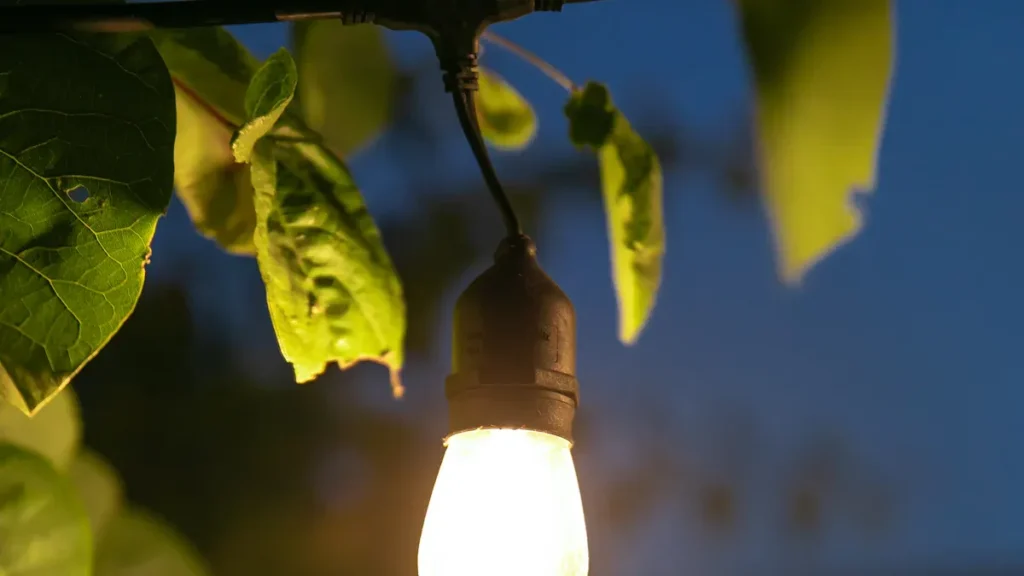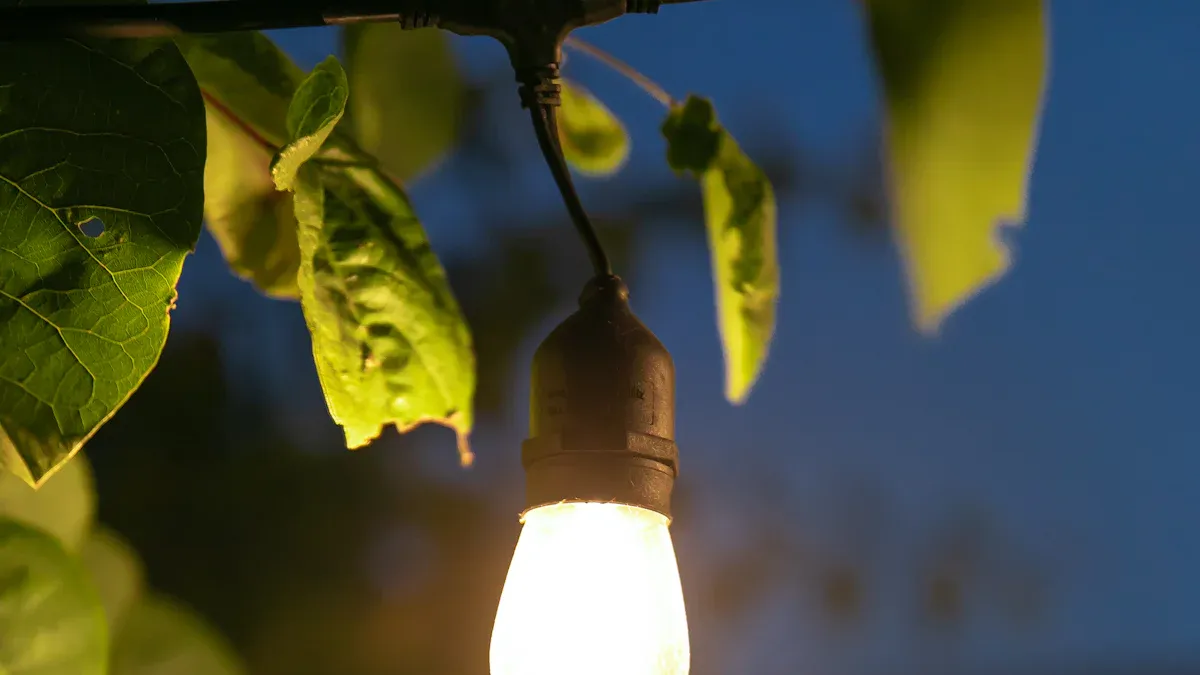
If you want your yard to be bright and use less energy, low voltage garden light bulbs are a good choice. LEDs are a smart option. Here is how these bulbs compare:
Bulb Type | Energy Efficiency | Lifespan |
|---|---|---|
LED | Uses up to 80% less energy | 25,000 to 50,000 hours |
Halogen | Uses more energy | 2,000 to 5,000 hours |
Incandescent | Uses more energy | Similar to halogen |
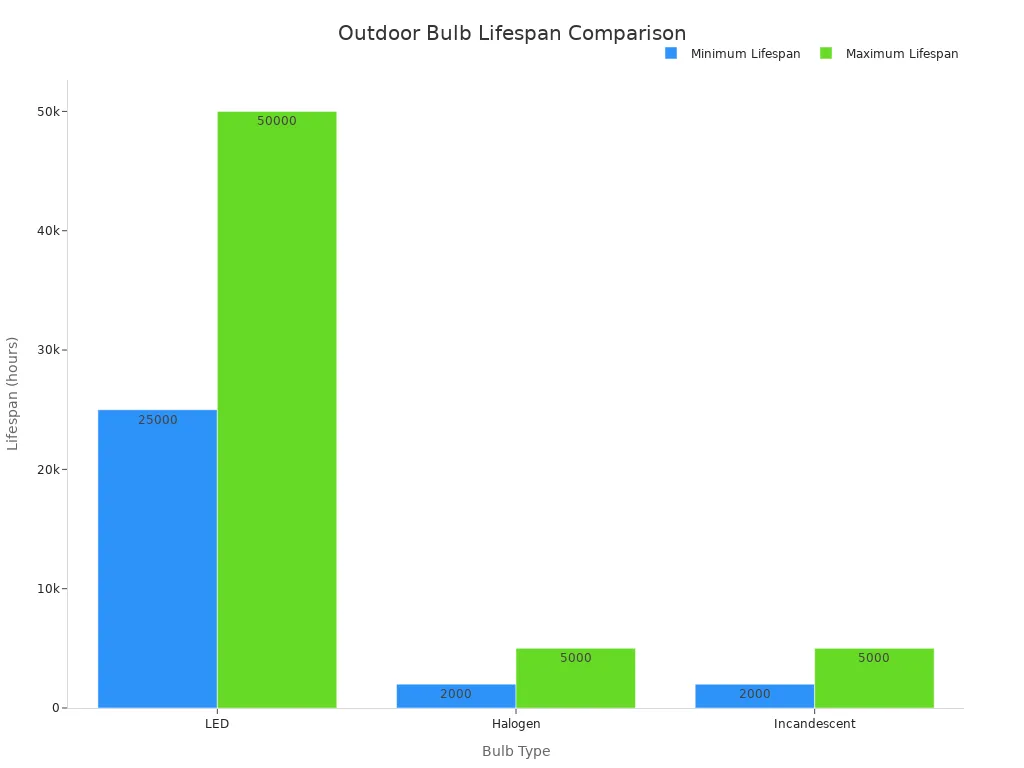
You can pick the best lighting for your yard. Think about how bright you want it. Think about the mood you like. Also, think about the weather in your area.
Key Takeaways
Pick LED garden light bulbs to save energy. They use up to 80% less energy than others. They can last from 25,000 to 50,000 hours. This helps you save money on your electric bills.
Think about how bright you want your bulbs to be. Use the right lumens for each area in your yard. This helps you make the yard look the way you want.
Make sure the bulbs fit your fixtures and transformers. This helps your lights work well and last longer.
Key Factors
Brightness
When you pick garden light bulbs, brightness matters a lot. You want enough light to see, but not so much that it feels harsh. Check out this table to see how many lumens work best for different outdoor spots:
Lighting Application | Recommended Lumens |
|---|---|
Step Lights | 12-100 |
Hardscape Lights | 50-185 |
Landscape Lights | 50-300 |
Path Lights | 100-200 |
Landscape Spotlights | 120 |
Lamp Posts | 120-180 |
Pond/Pool Lights | 200-400 |
Motion Sensor Lights | 300-700 |
Flood Lights | 700-1300 |
LED garden light bulbs give you more brightness for less power. For example, a 7-watt LED can shine as bright as a 60-watt incandescent bulb.
Energy Efficiency
You can save a lot of money by choosing energy-efficient bulbs. LED garden light bulbs use 90% less energy than old-fashioned bulbs. Most LEDs only use 4 to 28 watts, while halogen or incandescent bulbs can cost $20-$25 per month to run. If you switch to LEDs, you might pay just $1.70 a year for five hours of use each night. That’s a big difference!
💡 Tip: LEDs last longer and help lower your electricity bill.
Durability
Outdoor lights need to handle rain, dust, and wind. Look for bulbs with a high IP rating, like IP65 or higher. This means your lights can stand up to tough weather and keep working for years. LED garden light bulbs can last over 25,000 hours, which means you won’t have to replace them often.
Color Temperature
The color of your lights changes the mood in your yard. Here’s a quick guide:
Color Temperature | Mood Description | Best Uses |
|---|---|---|
2200K – 2700K | Relaxing, cozy | Patios, decks |
3000K | Inviting, natural | Pathways, gardens |
4000K & Up | Modern, dramatic | Water features, modern homes |
If you want to protect wildlife, choose warm colors below 3000K. These are less likely to bother animals at night.
Compatibility
Before you buy new garden light bulbs, make sure they fit your fixtures and work with your transformer. Low voltage systems need the right transformer to avoid burning out your bulbs. Always check the base type and voltage so everything works together.
Types of Garden Light Bulbs
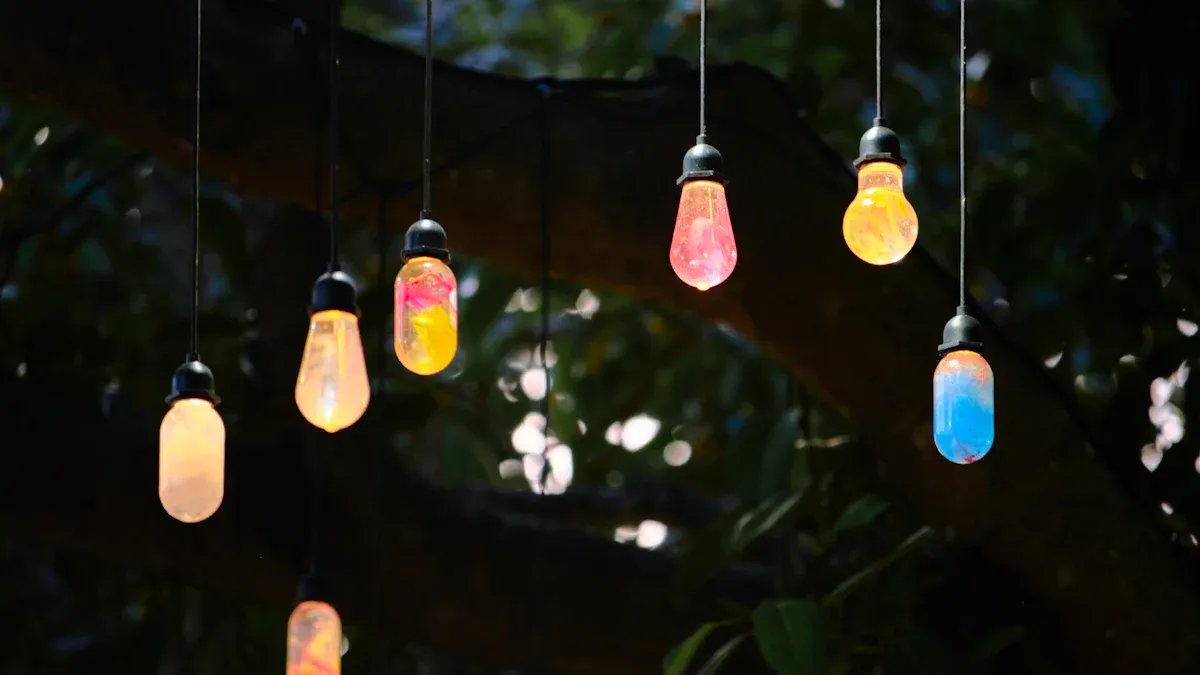
When you shop for garden light bulbs, you’ll notice several types. Each one has its own strengths. Let’s break down the most popular options so you can pick what works best for your yard.
LED Bulbs
LED bulbs have become the top choice for outdoor lighting. You get bright light, low energy bills, and bulbs that last for years. Even though LEDs cost more at first, you save money over time because you don’t have to replace them often.
Here’s a quick look at how LED bulbs compare to other types:
Bulb Type | Characteristics | Benefits |
|---|---|---|
LED | Energy-efficient, long-lasting, cool to touch, weather-resistant | Cost-saving, smart features |
Incandescent | Warm light, inexpensive, easy to replace | Classic look, easy to find |
Halogen | Bright, clear light, more efficient than incandescent | Good for security, focused light |
CFL | Energy-saving, budget-friendly, soft light | Longer life, lower energy bills |
You can use LED bulbs almost anywhere outside. They work great for:
Pathway lighting
Deck and patio lights
Security lights
Pool and pond lighting
Accent lights for plants or statues
LEDs come in many shapes and sizes. Some of the most common types for gardens include MR16, MR11, PAR36, G4, R7S, S8, and T5. The Feit Electric T5 is a popular pick if you want a slim, bright option.
💡 Tip: LED bulbs use up to 80% less energy than old bulbs. They also last up to 50,000 hours, so you won’t need to change them often.
LEDs are also safer for the environment. They don’t have toxic chemicals and you can recycle them. Their long life means less waste, and their low energy use helps cut down on pollution.
If you use a low voltage system, you may need an LED driver. This device keeps the power steady and helps your bulbs last longer.
Halogen Bulbs
Halogen bulbs give you bright, clear light. They work well if you want to highlight a tree or statue. Halogens are more efficient than old incandescent bulbs, but they still use more energy than LEDs.
Here’s how halogen bulbs stack up:
Feature | LED | Halogen |
|---|---|---|
Color Options | Warm to cool (2700K–5000K) | Mostly warm (2700K–3000K) |
Brightness | High (lumens per watt) | Moderate |
Halogen bulbs usually last about 4,000 hours. You might need to replace them every year or two, depending on how much you use them. They can get hot, so be careful when you touch them.
Some common halogen types for gardens are MR16, PAR36, and JC Bi Pin. You can use them for spotlights, path lights, or accent lighting.
⚠️ Note: Halogen bulbs cost less up front, but you’ll spend more on replacements and energy over time.
Incandescent and Specialty Bulbs
Incandescent bulbs give off a warm, cozy glow. They are cheap and easy to find, but they don’t last long. Most only work for about 1,000 hours. They also use a lot of energy and can get very hot.
Here’s a chart that shows how long different bulbs last:
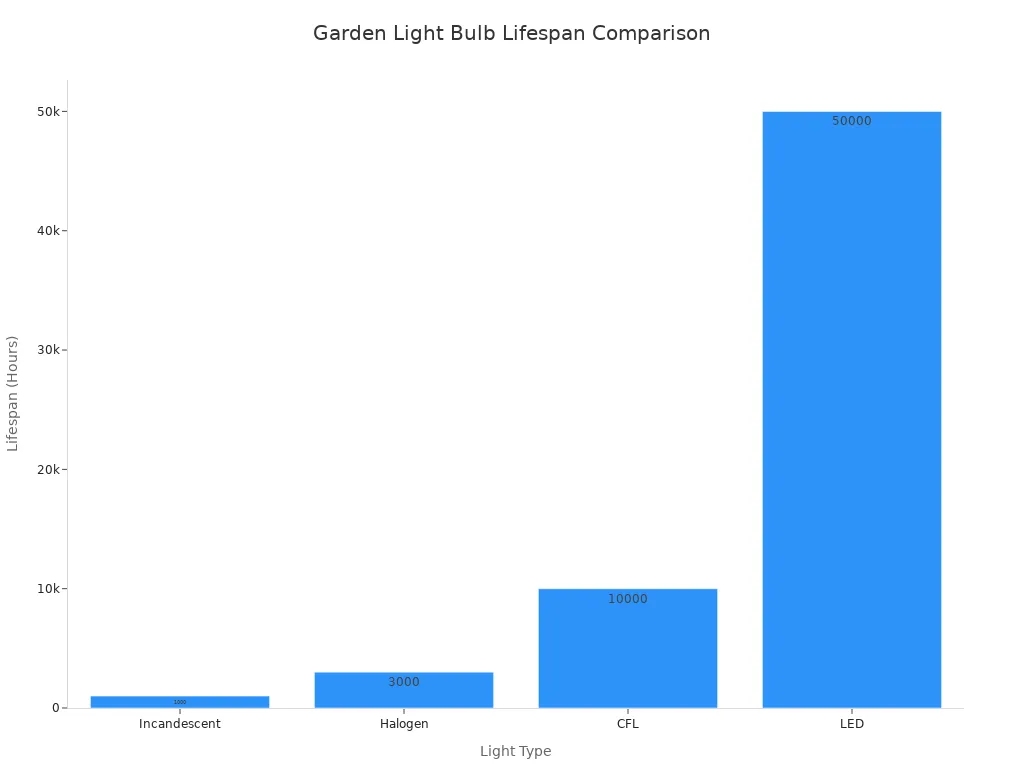
Incandescent bulbs work best for short-term use or special events. If you want a classic look for a party, they can be a good choice. But for everyday garden lighting, you might want something that lasts longer.
You can also find specialty bulbs for unique effects. Some popular types include:
LED G4 Bulbs
LED MR16 Bulbs
LED PAR36 Bulbs
JC Bi Pin Halogen Bulbs
MR16 Halogen Bulbs
PAR36 Halogen Bulbs
These specialty bulbs help you create fun lighting effects, highlight garden features, or add color to your yard.
🌟 Tip: If you want to save money and energy, try to use LED garden light bulbs for most of your outdoor spaces.
Best Bulbs by Area
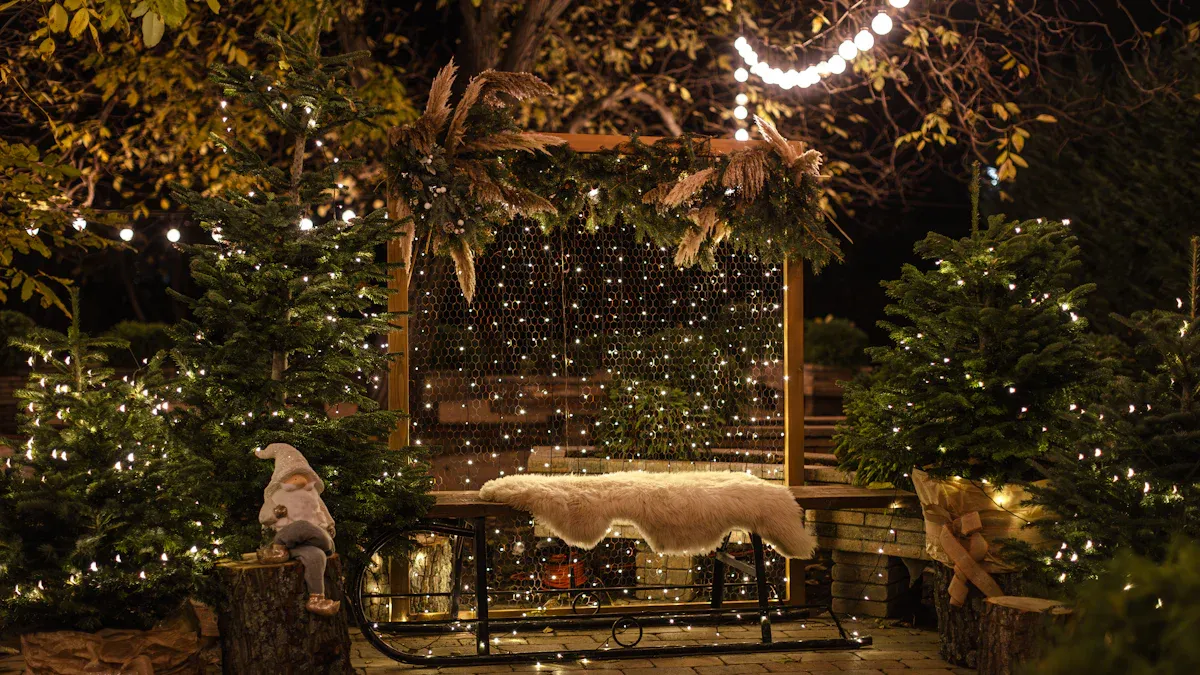
Pathways
You want your pathways to feel safe and look great at night. The best options for pathway lighting are LED, solar, and low voltage lights. Each type brings something special to your yard.
Type of Lighting | Benefits | Aesthetics |
|---|---|---|
LED | Energy efficient, long lifespan | Modern, bright illumination |
Solar | Eco-friendly, easy installation | Natural, soft glow |
Low Voltage | Safe, cost-effective | Soft, inviting atmosphere |
LED Pathway Lighting: Saves energy and lasts a long time.
Solar Pathway Lights: Uses sunlight, so you don’t pay extra for power.
Low Voltage Pathway Lights: Easy to install and gives a cozy feel.
Spacing and brightness matter, too. Check out this chart for the best spacing based on brightness:
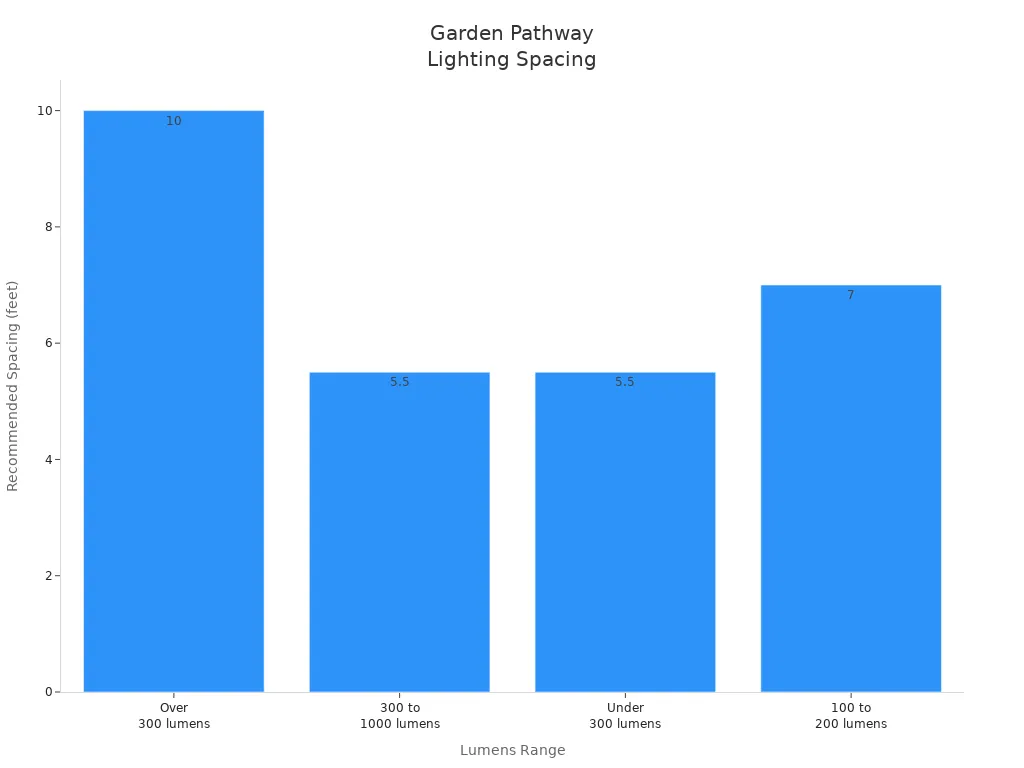
Tip: For most pathways, lights with 100 to 200 lumens spaced 6 to 8 feet apart work well.
Accent Lighting
Accent lighting helps you show off your favorite plants or garden features. You can use spotlights, uplights, or downlights for different effects.
Type of Bulb | Application |
|---|---|
Spotlights | Highlight statues, fountains, or special plants |
Uplights | Shine up on trees or walls for a dramatic look |
Downlights | Create a soft, natural glow from above |
Halogen bulbs work well for accent lighting. They make colors pop and textures stand out. You get a warm, inviting glow and sharp shadows that bring your garden to life.
Security Lighting
You want your yard to feel safe at night. High-brightness LED bulbs are the best pick for security lighting. They use less energy, last longer, and help you save money over time. Even though LEDs cost more at first, you spend less on electricity and replacements. Plus, they help the planet by using less power.
Decorative Lighting
Decorative lighting lets you set the mood for parties or quiet nights outside. Try string lights for a fun, boho vibe. Fairy lights work well for wrapping around trees or fences. Lanterns add a soft glow to tables or patios.
String Lights: Great for hanging across trees or pergolas.
Fairy Lights: Tiny bulbs that make any spot feel magical.
Lanterns: Easy to move and perfect for cozy corners.
Color-changing bulbs can make your garden feel extra special. They let you switch up the look for holidays or just for fun.
Installation and Care
Setup Tips
Getting your garden lights set up doesn’t have to be hard. You can make the process smooth by following a few simple steps:
Place your transformer in a dry spot close to a power source. This helps prevent voltage drop and keeps your lights shining bright.
Pick high-quality, UV-resistant wire. Choose the right wire gauge for your fixtures and the distance from the transformer. This keeps your system safe and running well.
Always check that your bulbs match your fixtures and transformer. Using the right LED driver for low voltage systems gives your bulbs steady power and helps them last longer.
Follow local codes and safety rules. This keeps you and your yard safe.
Think about the environment. Choose energy-saving fixtures and warm color bulbs to protect local wildlife.
💡 Tip: Test your lights before you bury any wires. This way, you can fix any problems right away.
Maintenance
Taking care of your garden lights helps them last longer and work better. When you clean and check your fixtures often, you stop dirt and water from causing damage. This keeps your lights bright and your yard looking great.
Regular maintenance also makes your outdoor space safer. You lower the risk of tripping or electrical problems. If you use solar lights, wipe the panels clean so they can soak up more sunlight and shine longer at night.
🧹 Note: A little care goes a long way. Clean your lights every few months and check for loose wires or broken bulbs. This simple habit keeps your garden glowing year-round.
LED low voltage garden bulbs work best for most yards. You should look at your space and decide what you want from your lights. Use the tips above to install and care for your bulbs.
Ready to brighten your yard? Pick the bulbs that fit your style and needs!
FAQ
What is the best bulb for wet or rainy areas?
You should pick LED bulbs with a high IP rating, like IP65. These bulbs can handle rain and keep shining bright.
Can I mix different types of bulbs in my garden?
Yes, you can mix them. Just make sure each bulb matches your fixture and transformer. Mixing can help you create a unique look.
How often do I need to replace LED garden bulbs?
Most LED garden bulbs last for years. You might not need to change them for 5 to 10 years, depending on how much you use them.

